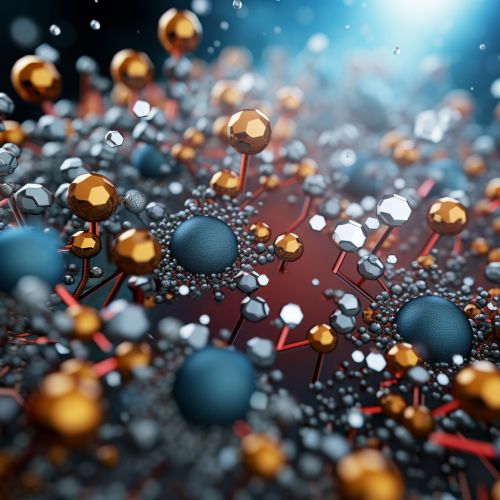Metal nanoparticles
Introduction
Metal nanoparticles, also known as nanoscale particles, are particles that range in size from 1 to 100 nanometers. They are composed of metals such as silver, gold, platinum, titanium, and others. These nanoparticles have unique properties due to their small size and high surface area to volume ratio, which make them useful in various applications in fields such as nanotechnology, biomedicine, and material science.


Properties of Metal Nanoparticles
Metal nanoparticles exhibit unique physical and chemical properties that differ significantly from those of their bulk counterparts. These properties can be broadly classified into optical, electronic, magnetic, and catalytic.
Optical Properties
The optical properties of metal nanoparticles are primarily due to the phenomenon known as surface plasmon resonance (SPR). SPR is a collective oscillation of conduction electrons at the nanoparticle surface, induced by incident light. This phenomenon results in strong absorption and scattering of light, which can be tuned by changing the size, shape, and composition of the nanoparticles.
Electronic Properties
The electronic properties of metal nanoparticles are governed by quantum size effects. As the size of the nanoparticles decreases, the energy levels become discrete rather than continuous, leading to quantization of energy levels. This quantization results in unique electronic properties such as high electrical conductivity and enhanced catalytic activity.
Magnetic Properties
Certain metal nanoparticles, such as those made of iron, cobalt, and nickel, exhibit superparamagnetism. This is a form of magnetism which appears in small ferromagnetic or ferrimagnetic nanoparticles. Superparamagnetic nanoparticles have high magnetic susceptibilities and their magnetization can be easily aligned along an applied magnetic field, but they exhibit no residual magnetism when the field is removed.
Catalytic Properties
Metal nanoparticles are known for their exceptional catalytic properties. The high surface area to volume ratio and the presence of a large number of surface atoms enhance their catalytic activity. They are used as catalysts in various chemical reactions, including hydrogenation, oxidation, and reduction reactions.
Synthesis of Metal Nanoparticles
There are several methods for the synthesis of metal nanoparticles, which can be broadly classified into top-down and bottom-up approaches.
Top-Down Approach
The top-down approach involves breaking down larger particles into smaller ones. Methods used in this approach include ball milling, etching, and lithography. However, these methods often result in nanoparticles with a broad size distribution and irregular shapes.
Bottom-Up Approach
The bottom-up approach involves building up nanoparticles from atoms or molecules. Methods used in this approach include chemical reduction, sol-gel synthesis, and green synthesis. These methods allow for better control over the size and shape of the nanoparticles, but they often require the use of toxic chemicals.
Applications of Metal Nanoparticles
Due to their unique properties, metal nanoparticles find applications in various fields.
Nanotechnology
In nanotechnology, metal nanoparticles are used in the fabrication of nanodevices and nanosensors. For example, gold nanoparticles are used in the construction of quantum dots and nanowires, which are used in electronic and optoelectronic devices.
Biomedicine
In biomedicine, metal nanoparticles are used in drug delivery, imaging, and therapy. For example, gold nanoparticles are used as carriers for drug delivery, while iron oxide nanoparticles are used in magnetic resonance imaging (MRI) and as therapeutic agents in hyperthermia treatment.
Material Science
In material science, metal nanoparticles are used to enhance the properties of materials. For example, silver nanoparticles are used to impart antimicrobial properties to textiles, while titanium dioxide nanoparticles are used to improve the photocatalytic properties of coatings.
